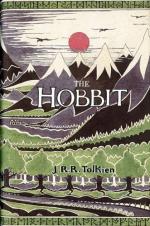
|
| Name: _________________________ | Period: ___________________ |
This test consists of 5 short answer questions, 10 short essay questions, and 1 (of 3) essay topics.
Short Answer Questions
1. Why can Bard understand the speech of the thrush?
2. What is the name of the hill close to where the dwarves and Bilbo make their first camp approaching the Lonely Mountain?
3. How does Bilbo manage to recognize Thorin after freeing him from the barrel?
4. In Chapter 12, who volunteers to come some of the way down the tunnel with Bilbo?
5. Who carries the wooden casket holding the Arkenstone to the parley with Thorin?
Short Essay Questions
1. Why does Bombur remain in the lower camp with the ponies and supplies in Chapter 11?
2. What dreams or legends do the Lakemen have regarding the King Under the Mountain and Smaug?
3. What advice does Roac the raven give to Thorin in this Chapters 15 & 16?
4. Upon what does Bard the Bowman base his claim to a share of the dragon's treasure?
5. Explain the meaning of the ambiguous or riddling answers Bilbo gives to Smaug to avoid revealing his name to the dragon (and thus giving the dragon power over him)?
6. Why does Thorin refuse to share the treasure with Bard and his allies and treat them with hostility?
7. What details are given in Chapter 11 as hints to an alert reader that the one chance of finding the keyhole is about to present itself?
8. What effect does the sight of the treasure have on the dwarves?
9. Why does Bilbo give the Arkenstone to Bard the Bowman?
10. Why does Smaug laugh when Bilbo tells him that revenge is one of the motives of their quest?
Essay Topics
Write an essay for ONE of the following topics:
Essay Topic 1
Tolkien uses several traditional fantasy races in the setting of The Hobbit, including elves, dwarves, goblins, trolls and dragons. In you own words, describe what two of these fantasy races are like, using evidence from the text rather than from wider reading. Your answer should cover appearance, typical behavior and whether the race is, in general, "good" or "evil."
Essay Topic 2
In building his fantasy world, Tolkien has used fantastic or imaginary elements as well as familiar and real-world elements in order to make his world believable.
Part 1. List and describe some familiar and real-world elements that appear within The Hobbit.
Part 2. List and describe the fantastic or imaginary (magical) elements that appear within this book.
Part 3. Evaluate whether Tolkien has managed to integrate the fantastic with the everyday successfully or not.
Essay Topic 3
According to Joseph Cambell's classic analysis of myths, quests and adventure stories (Hero with a Thousand Faces), the classical or archetypal pattern for a mythological quest or adventure is as follows:
1 The call to adventure. The hero usually finds a helper at this stage.
2. The hero crosses the "threshold of adventure."
3. The hero faces various tests and receives magical aid that will help him achieve his quest.
4. The hero faces the final test, which can be the theft of an important talisman, elixir or object.
5. The hero faces another challenge before bringing peace, prosperity, or some other boon to humanity.
Using this outline, does The Hobbit fit the archetypal pattern of a quest adventure? What events and incidences fit into what part of the pattern? Are any parts of the pattern omitted? Does The Hobbit contain any events or incidents that do not fit the pattern?
|
This section contains 1,825 words (approx. 7 pages at 300 words per page) |

|




